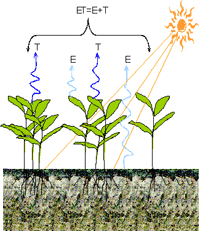Agricultural Research Division of IANR

West Central Research and Extension Center, North Platte
Date of this Version
2009
Citation
ASABE Annual International Meeting Sponsored by ASABE Grand Sierra Resort and Casino, Reno, Nevada June 21 – June 24, 2009
Abstract
Subsurface drip irrigation (SDI) has the potential of being a more efficient irrigation system compared to systems such as center pivot and furrow irrigation. The objective of this study was to determine the effect of the amount and timing of irrigation, using SDI, on corn (Zea mays) production. A field study was conducted at North Platte, Nebraska in 2007 and 2008, using two SDI systems. The study was replicated eight times on the older SDI system (SDI1) and four times on the newer SDI system (SDI2). On SDI1, there were nine treatments to impose different irrigation regimes, ranging from dryland to fully irrigated. Five of the nine treatments allowed water stress only after tasseling and silking. On SDI2, there were eight treatments that were very similar to the nine on SDI1.
In 2007, on SDI1, mean corn yield ranged from 7.8 Mg ha-1 with a season total of 57 mm of irrigation water to 11.1 Mg ha-1 for the fully irrigated treatment (253 mm of irrigation water). On SDI2, yield increased from 8.9 Mg ha-1 with 41 mm to 11.5 Mg ha-1 with 264 mm (fully irrigated). The least-irrigated treatment (158 mm) of the four treatments allowing water stress only after tasseling and silking, had a mean yield of 10.9 Mg ha-1, only 0.6 Mg ha-1 less than the fully irrigated treatment (264 mm). Soil water content fell well below 0.20 m3 m-3 (below 50% depletion of soil available water) in the second part of August and in September for the former treatment (158 mm), suggesting that some drying out of the soil below 50% depletion towards the end of the growing season causes only a modest reduction in corn yield. In 2008, yields were suppressed across the irrigation treatments. Amount or timing of irrigation did not have much of an effect on yields, except for the dryland treatment where yield was substantially less than for the other treatments. Water conservation with SDI has the potential to help irrigators to significantly reduce pumping cost and more water would be available for competing needs. More research is needed to document and quantify this water conservation potential of SDI.


Comments
Copyright 2009 ASABE. Used by permission.